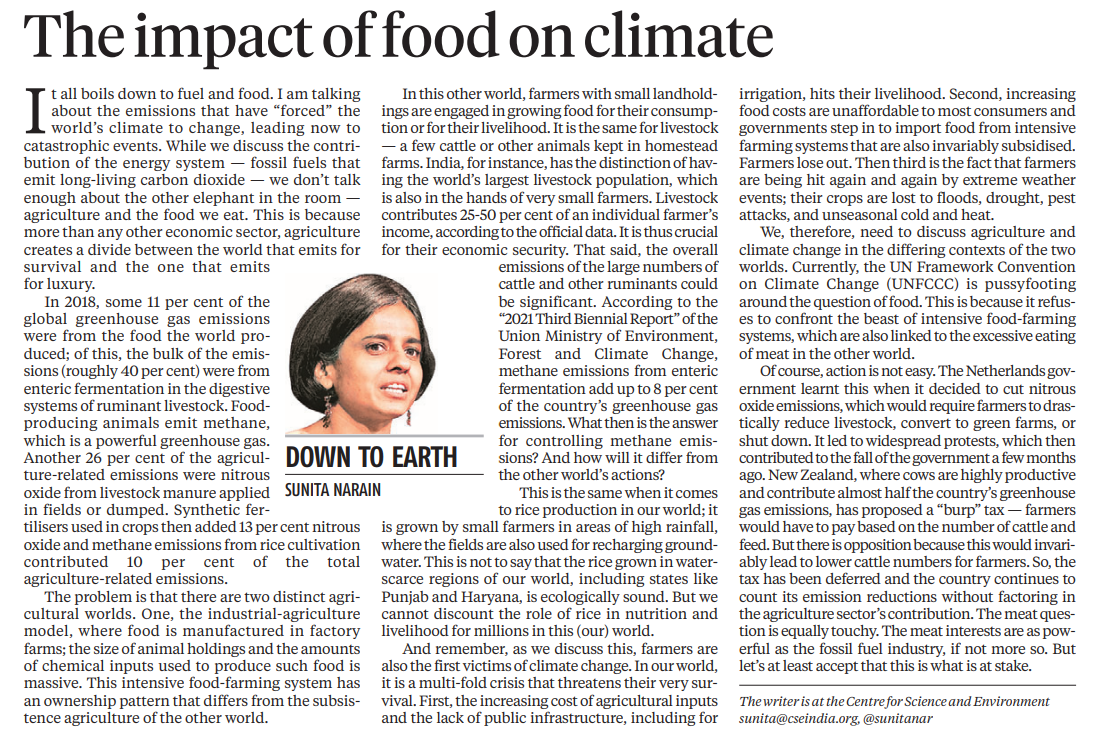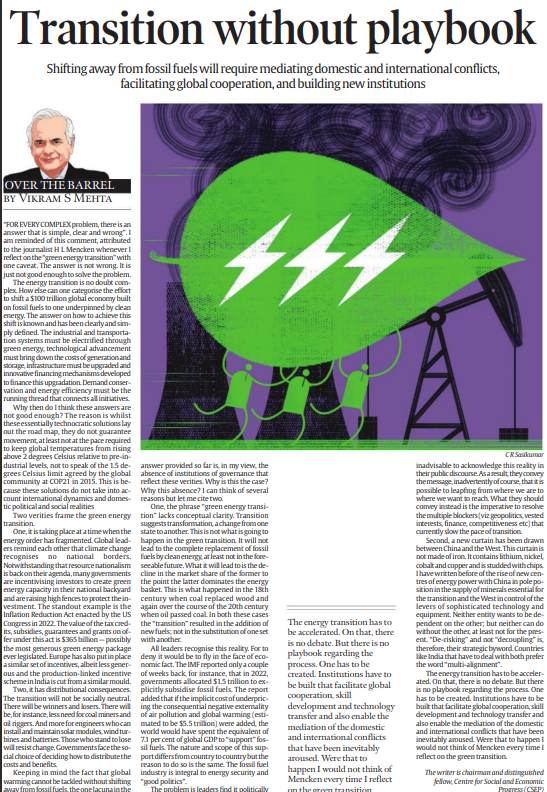THE CLIMATE CRISIS: EXAMINING THE ROLE OF AGRICULTURE AND FOOD
Introduction
- The global climate crisis has pushed the world into a state of emergency, with catastrophic events becoming increasingly common.
- While discussions often revolve around the energy sector and its contribution to climate change through carbon emissions, there is a significant lack of discourse on agriculture and the food production industry.
- Agriculture, responsible for 11% of global greenhouse gas emissions in 2018, plays a pivotal but underappreciated role in climate change.
Agriculture’s Emissions Breakdown
- Enteric Fermentation and Methane Emissions:
– Approximately 40% of agriculture-related emissions stem from enteric fermentation in the digestive systems of ruminant livestock. These animals emit methane, a potent greenhouse gas.
- Nitrous Oxide from Livestock Manure:
– Another 26% of emissions in agriculture result from nitrous oxide released when livestock manure is applied in fields or disposed of improperly.
- Synthetic Fertilizers and Rice Cultivation:
– Synthetic fertilizers used in crop production contribute 13% of nitrous oxide emissions.
– Methane emissions from rice cultivation make up 10% of agriculture-related emissions.
The Two Distinct Agricultural Worlds
- Industrial Agriculture Model:
– Characterized by factory farms, large animal holdings, and extensive use of chemical inputs.
– This model primarily serves the luxury segment of food production.
- Subsistence Agriculture:
– Small-scale farmers grow food for consumption and livelihood.
– In countries like India, small farmers dominate livestock ownership, and livestock often account for a significant portion of their income.
Impact on Farmers
- Economic Security:
– Livestock contribute substantially to small farmers’ income, providing economic security.
- Climate Vulnerability:
– Small farmers are among the first victims of climate change.
– Rising input costs, inadequate infrastructure, and extreme weather events threaten their livelihoods.
Differing Contexts of Agriculture and Climate Change
- UN Framework Convention on Climate Change (UNFCCC):
– Currently avoids addressing the issue of food production, particularly intensive food-farming systems.
– The UNFCCC’s reluctance stems from the challenge of confronting powerful interests and the excessive consumption of meat in developed nations.
Challenges in Taking Action
- Netherlands’ Nitrous Oxide Reduction Efforts:
– Drastic measures required to reduce nitrous oxide emissions, such as reducing livestock or transitioning to green farming, led to widespread protests and contributed to the fall of the government.
- New Zealand’s “Burp” Tax Proposal:
– Proposed tax based on cattle numbers and feed consumption faced opposition due to potential impacts on farmers.
– The country continues to calculate emission reductions without addressing the agriculture sector’s contribution.
Conclusion
The climate crisis is intrinsically linked to agriculture and the food we consume. Two distinct agricultural worlds exist: industrial agriculture serving luxury markets and subsistence farming supporting small-scale farmers.
Addressing climate change necessitates acknowledging the significant role of agriculture in emissions and considering the differing contexts of these two worlds. Although challenging, confronting intensive food-farming systems and meat consumption is essential to mitigate climate change’s devastating effects.
INDIA'S GEOPOLITICAL AND GEO-ECONOMIC POSITIONING AT THE G-20 SUMMIT
Introduction
- India is currently hosting the G-20 summit, positioning itself favorably in the geopolitical and geo-economic landscape.
- This newfound recognition is driven by its robust economy, youthful population, democratic values, and pragmatic foreign policy.
- India appears poised to shed its historical constraints and step onto the global stage.
Consolidation of the Indian State
- Historical Promise vs. Potential Realization: For years, India had been seen as a nation with immense potential but limited realization. However, the recent shift in global attention towards India can be attributed to its ability to strengthen its internal coherence and the efficacy of its state apparatus.
- Improved Internal Security: India has made significant strides in managing domestic terrorism, achieved through strengthening internal security mechanisms and maintaining a vigilant stance against external threats.
- Critical Role of Article 370 Abrogation: The abrogation of Article 370 and 35A, leading to the bifurcation of Jammu and Kashmir into two Union Territories, marked a pivotal moment. The government’s reform agenda, while still evolving, reflects a commitment to address the long-standing Kashmir issue.
- China’s Concerns: China’s aggressive stance in Ladakh demonstrates its recognition that India’s policy measures can alter the strategic dynamics of the region, potentially to China’s disadvantage.
Engagement in the Northeast
Transforming the Region: India’s Northeast, previously overlooked by New Delhi, has become a focus area, creating a more holistic national identity. This region serves as a crucial link between India and Southeast Asia, bolstering India’s claim as an Indo-Pacific power.
Multidimensional Approach: Policymakers have revitalized the Northeast as an economic and cultural hub. The region has seen a decrease in insurgent activities, security issues, and civilian casualties due to improved governance and security conditions.
Removal of AFSPA: The removal of the Armed Forces (Special Powers) Act, 1958 (AFSPA) from substantial portions of the Northeast attests to the progress made in terms of security.
Marginalization of Left-wing Extremism (LWE)
Security Forces’ Success: Indian security forces have gained the upper hand over Maoist insurgents, partly due to financial constraints and targeting of top leadership. A comprehensive government approach combining security and development initiatives has significantly reduced the LWE threat.
From Existential Threat to Marginalization: Once perceived as the most serious internal security challenge, Maoists no longer pose an existential threat to India, thanks to better governance and security measures.
The Importance of a Strong State
- Beyond Resources: Simply having resources does not elevate a country to a major global player. India’s historical perception as a “strong society, weak State” must change.
- Internal Security for External Engagement: India’s claims to global leadership hinge on demonstrating effective governance and control over internal security. A strong State is essential for leveraging the nation’s economic prowess in international engagements.
Conclusion
India’s hosting of the G-20 summit signifies its growing influence and recognition on the global stage.
The country’s ability to consolidate internally, address historical challenges, and ensure security has contributed to its newfound credibility as a global leader.
As India continues to evolve, its policymakers are learning the importance of a strong State in shaping its global role.
NAVIGATING THE GREEN ENERGY TRANSITION: BEYOND SIMPLE SOLUTIONS
Introduction
- The quote “For every complex problem, there is an answer that is simple, clear and wrong” attributed to journalist H.L. Mencken is a fitting lens through which to analyze the challenges and solutions presented by the green energy transition.
- While the proposed solutions may seem straightforward, they fall short in addressing the complexity of the issue.
The Complexity of the Energy Transition
The transition from a fossil fuel-based global economy to one based on clean energy is a monumental task.
The key elements of this shift are well-defined:
- Electrification of industrial and transportation systems.
- Technological advancements to reduce generation and storage costs.
- Infrastructure upgrades.
- Innovative financing mechanisms.
- Emphasis on demand conservation and energy efficiency.
The Limitations of Technocratic Solutions
While these technocratic solutions provide a roadmap for the energy transition, they are insufficient to achieve the necessary pace to prevent global temperatures from exceeding critical thresholds (e.g., 2 degrees Celsius). The primary reasons for this inadequacy are:
- Neglecting International Dynamics
The green energy transition occurs in a fragmented energy landscape, with countries increasingly incentivizing domestic investments in green energy. The example of the Inflation Reduction Act in the U.S., offering substantial incentives, reflects this trend. Europe and India have followed suit with similar measures. These nationalistic tendencies can hinder global cooperation.
- Distributional Consequences
The transition will create winners and losers in society, impacting employment and economic sectors. Coal miners and oil rig workers may face job losses, while engineers in renewable energy sectors may benefit. Governments face the challenge of balancing these costs and benefits while ensuring a just transition.
The Absence of Governance Institutions
Despite the clarity of the proposed solutions, the transition lacks the necessary governance institutions to address its unique challenges. Two key reasons for this absence are:
- Conceptual Clarity
The phrase “green energy transition” lacks conceptual clarity. Unlike past energy transitions that completely replaced one fuel source with another, this transition will involve the coexistence of fossil fuels and clean energy for the foreseeable future. Leaders must acknowledge this reality and address it honestly in their public discourse.
- The China-West Divide
A new division between China and the West has emerged, with China controlling essential minerals for clean energy and the West leading in advanced technology. Both entities need each other, but neither wants to be overly dependent. “De-risking” rather than “decoupling” characterizes their approach, causing additional complexity for the transition.
The Urgent Need for Institutional Development
The green energy transition must be accelerated, but there is no established playbook for the process. To address the complexity of the transition, institutions must be built to:
– Facilitate global cooperation.
– Promote skill development and technology transfer.
– Mediate domestic and international conflicts arising from the transition.
Conclusion
The green energy transition is a complex problem that demands more than simple, technocratic solutions. Addressing the international dynamics, distributional consequences, and governance challenges is essential to ensure a successful and timely transition.
The creation of effective institutions to navigate these complexities is imperative for achieving the transition’s goals and avoiding the pitfalls of oversimplified answers.




